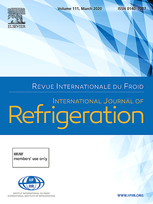
Summary
The absorption-cycle technology driven by low-grade thermal energy has attracted significant attention. Hydrofluoroolefins refrigerant and ionic-liquid absorbent have been currently proposed as the promising candidates to traditional NH3/H2O and H2O/LiBr working pairs. The properties of refrigerant/absorbent pairs have a vital impact on the efficiency of an absorption-refrigeration cycle, especially the solubility of the gaseous refrigerant in an absorbent. In this work, solubilities were measured for two new working pairs (R1234ze(E)/[P66614][Cl] and R1233zd(E)/[P66614][Cl]) by an isochoric saturation method at the temperature range from 283.15 to 343.15 K. Solubilities increase with the increase of pressure and decrease with increase of temperature. To assess solubility model of refrigerant/IL pairs, the Krichevsky-Ilinskays (KI) equation and Nonrandom Two-Liquid (NRTL) model were used to correlate the new data. From the results, we found that the NRTL model could provide smaller deviations than KI equation. In contrast with the existing IL, the [P66614][Cl] has the highest solubility. Furthermore, the enthalpy, entropy, and Gibbs energy of dissolution were estimated.
Available documents
Format PDF
Pages: 178-185
Available
Public price
20 €
Member price*
Free
* Best rate depending on membership category (see the detailed benefits of individual and corporate memberships).
Details
- Original title: Absorption behavior for R1234ze(E) and R1233zd(E) in [P66614][Cl] as working fluids in absorption refrigeration systems.
- Record ID : 30029126
- Languages: English
- Source: International Journal of Refrigeration - Revue Internationale du Froid - vol. 131
- Publication date: 2021/11
- DOI: http://dx.doi.org/10.1016/j.ijrefrig.2021.07.020
- Document available for consultation in the library of the IIR headquarters only.
Links
See other articles in this issue (95)
See the source
Indexing
-
Themes:
Absorption and adsorption systems;
HFO et HCFO - Keywords: Absorption system; R1234ze(E); R1233zd(E); HFO; Solubility; Working fluid; Measurement; Expérimentation
-
Study on the adsorption characteristics of Maxs...
- Author(s) : YE L., ISLAM A., RUPAM T. H., JAHAN I.
- Date : 2023/02
- Languages : English
- Source: International Journal of Refrigeration - Revue Internationale du Froid - vol. 146
- Formats : PDF
View record
-
Experimental investigation on the viscosity of ...
- Author(s) : ZHANG Y., JIA X., WANG X.
- Date : 2020/09
- Languages : English
- Source: International Journal of Refrigeration - Revue Internationale du Froid - vol. 117
- Formats : PDF
View record
-
Analysis of hybrid compression absorption refri...
- Author(s) : ASENSIO-DELGADO J. M., ASENSIO-DELGADO S., ZARCA G., URTIAGA A.
- Date : 2022/02
- Languages : English
- Source: International Journal of Refrigeration - Revue Internationale du Froid - vol. 134
- Formats : PDF
View record
-
Comparison of solubility of trans-1,3,3,3-tetra...
- Author(s) : ZHANG Z., YANG W., HE G., HUA J., ZOU Y., HOU Q., ZHENG X., ZHOU S.
- Date : 2024/10
- Languages : English
- Source: International Journal of Refrigeration - Revue Internationale du Froid - vol. 166
- Formats : PDF
View record
-
Effect of subsurface tunnel on the nucleate poo...
- Author(s) : JI W. T., XIONG S. M., CHEN L., ZHAO C. Y., TAO W. Q.
- Date : 2021/02
- Languages : English
- Source: International Journal of Refrigeration - Revue Internationale du Froid - vol. 122
- Formats : PDF
View record
